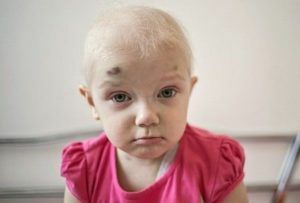
Which symptoms are typical for leukemia, which risk factors increase the risk of blood cancer, how the disease is treated and how common it is.
ICD-10: C90 – C95 leukemia
Medical contact points: General practitioner, general practitioner, hematologist
reading time: 8 minutes
What is leukemia?
The term "leukemia" (colloquially also "blood cancer") is an umbrella term for cancers that affect the blood-forming system.
With leukemia, the body makes too many white blood cells. These white blood cells are degenerate and not functional. They displace the healthy white and red blood cells. Functional white blood cells play an important role in the fight against invading pathogens.
A distinction is made between chronic and acute leukemia. The acute form is characterized by a rapid course of the disease, while the chronic form takes a creeping course. Both types experience symptoms such as fatigue, night sweats and weight loss. This disease can be diagnosed with the help of a blood count. To determine the form of the disease, is a Bone marrow examination necessary.
Leukemia symptoms

Persistent fatigue and a pronounced feeling of weakness are the main symptoms of leukemia (Photo: Photographee.eu | Shutterstock)
| The typical symptoms of leukemia |
|---|
| chronic fatigue |
| fatigue |
| striking pallor |
| rapid exhaustion |
| high susceptibility to infections |
| frequent nosebleeds |
| small red spots on the skin |
| anorexia |
| unexplained weight loss |
| bone pain |
| swollen lymph nodes |
| Swelling of the liver and spleen |
| a headache |
| frequent bleeding gums |
| dizziness |
| paralysis |
| numbness |
| Fever with no apparent cause |
| night sweats |
| difficulty in breathing |
| increased sweating |
| nausea |
| blurred vision |
| night sweats |
| itching |
| palpitations |
| pronounced feeling of illness |
Leukemia, popularly known as blood cancer, is a disease that severely damages blood formation. White blood cells are increasingly formed, which literally displace the red blood cells. Leukemia can occur in different forms at any age and therefore leads to very different symptoms.
The course and symptoms of leukemia strongly depend on the phase in which the disease occurs. Children’s leukemia has a different diagnostic view than leukemia in adults. However, the majority of patients affected by leukemia are adults. Most symptoms of leukemia are caused by a lack of healthy blood cells.
Above all, internal organs are damaged by the leukemic cells – that is, pathologically altered cells – and their function is therefore impaired. At the beginning, leukemia is rather gradual. The individual symptoms are hardly specific and do not necessarily indicate leukemia. The main symptoms of fatigue, listlessness and pale skin are symptoms that can also be psychologically, due to overwork or minor illnesses. Many people experience these symptoms at some point in their lives without developing leukemia.

The main symptoms of leukemia (Photo: Designua | Shutterstock)
The course is usually only noticeable when frequent infections occur with a high fever. In such a situation, many patients see a doctor. Blood tests usually give the first suspicion of leukemia.
Bleeding then occurs in the further course. This can be skin bleeding, bruising or increased bleeding gums. At the latest after such symptoms appear, it becomes clear that the hematopoietic system is affected.
In addition, symptoms appear that affect the entire body, but are not very specific. Loss of appetite and weight loss, which is not related to a change in diet or intense physical exertion, can also be an indicator of leukemia. Pain in the bones or swollen lymph nodes are also typical for leukemia patients. If internal organs are already damaged, they can be enlarged and cause pain.
Leukemia symptoms in children
Leukemia is the most common cancer in children. In adolescents, too, symptoms are first caused that are directly related to blood formation. The first thing parents notice is an unusual pallor.
Children with leukemia quickly become tired and are chronically listless. Since most children love exercise and live out intensively every day, this is often noticed more quickly than in adults. In addition to persistent general malaise, the general development of the children is impaired.
The pediatrician can easily identify anemia. But that alone is only an indication of leukemia, not a diagnosis. The duration of occurrence is important when considering the symptoms in children. Many of the unfortunately very unspecific symptoms also occur in healthy children, for example due to an unspecific infection or a growth phase. If the symptoms persist over a period of several weeks, justify you one Initial suspicion. A special symptom is night sweats, which occur very rarely in healthy children. Dizziness and a very low level of fitness are also important indicators. A visit to the pediatrician is strongly recommended, especially if several of these non-specific symptoms occur together.
Symptoms of acute leukemia
In acute leukemia, the speed with which the symptoms appear is always astonishing. A person who was completely healthy can show a severe clinical picture within a few days. Typical symptoms here are infections, which are often accompanied by a high fever and bring with them tiredness and fatigue. The blood disorder is also manifested by frequent bleeding from the nose or gums, an increased tendency to hematomas and bleeding from injuries that is difficult to stop. Patients experience severe pain in the bones and the lymph nodes can swell in various parts of the body. The spleen can also swell, which initially causes a feeling of fullness in the sick, which in turn often leads to anorexia. As the disease progresses, it happens whatever back to nausea and vomiting. The central nervous system is affected. The patient complains of headache and dizziness.
Symptoms of chronic leukemia
With chronic leukemia, the symptoms do not develop so suddenly. The disease is progressing more slowly. This is why a patient can often suffer from chronic leukemia for years before the disease is diagnosed. The symptoms that initially appear are usually non-specific, so they are not immediately associated with leukemia. The patient tired quickly and was often remarkably pale. There is also a fever for which no cause can be found. Headaches and a feeling of discomfort in the upper abdomen can occur. Spot bleeding is observed in some patients.
Patients with chronic leukemia often experience the disease by accident if the doctor orders a blood test for another reason. If a person is suspected of leukemia, some tests can quickly clarify. First of all, a blood test is carried out, the blood being examined for changed cells. In order to make a definitive diagnosis, the doctor takes a bone marrow sample from the pelvic bone.
distribution

Leukemia – a cancer of the hematopoietic system (Photo: Photographee.eu | Shutterstock)
In Germany, around 14,000 people develop new leukemia every year. Almost 60 percent of them survive the first five years after diagnosis. From the age of 30, the risk of illness increases continuously. Men are affected much more often than women.
Distribution across the different forms of leukemia:
- 7% acute lymphoblastic leukemia (ALL)
- 39% chronic lymphoblastic leukemia (CLL)
- 22% acute myeloid leukemia (AML)
- 8% chronic myeloid leukemia (CML)
treatment
Which form of therapy is indicated depends on the form of the disease. In most cases, leukemia is treated with radiation or chemotherapy. Since leukemia is the subject of intensive research, the spectrum of available treatment methods has expanded enormously in recent years:
- chemotherapy
- radiotherapy
- stem cell therapy
- Bone marrow transplant
- Antibody therapy
- Gene Therapy
causes
The causes of this disease have not yet been clearly determined. So far, however, genetic factors have mainly been mentioned as the cause.
risk factors
- genetic disposition
- radioactive radiation
- Down syndrome / trisomy
- Pollutants (solvents, insectic >Prominent patients
- Alex Alves (soccer player)
- Guido Westerwelle (politician)
- José Carreras (singer)
- Raissa Gorbacheva
Sebastian () has been working for online medical media for years. He volunteers in BOINC cancer research projects. Sebastian is married, has one child and lives in Berlin.
Do you suffer from leukemia or do you have someone in your family who is fighting this disease? How was leukemia discovered? How is it treated? With success?
Write to us your experiences, additions and questions – right below this article, in the comments. You are also helping other people affected.
RELATED ITEMS
-

Leukemia: symptoms in children and treatment of the disease
Symptoms of Childhood Leukemia Common Signs of Childhood Leukemia Which Tests Are Performed on Childhood Leukemia? How is leukemia…
-

Leukemia in children: symptoms, therapy, prognosis
Martina Feichter studied biology with an elective in pharmacy in Innsbruck and also delved into the world of medicinal plants. From there it was…
-

Diabetes in children »causes, symptoms & treatment
The vast majority (95%) of diabetic children develop congenital type 1 diabetes, the acquired form, type 2 diabetes, occurs…
-

Abdominal wall fracture: first signs, symptoms and treatment
The first signs of an abdominal wall rupture appear only veiled, which is why many of those affected initially do not notice the clinical picture….
